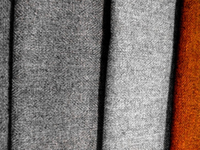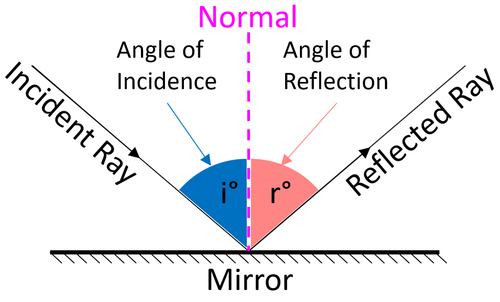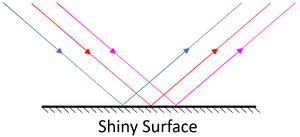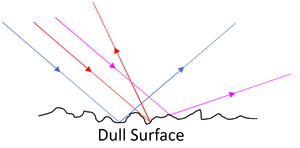Key Stage 2
Meaning
Reflection is when light bounces off a surface.
About Reflection
- Reflection can be specular or diffuse.
- Specular Reflection happens from a shiny surface and makes an image (you can see a 'reflection').
- Diffuse Reflection happens from a dull surface and is how we see all objects.
Key Stage 3
Meaning
Reflection is when a wave bounces off a surface.
About Reflection
- All waves can be reflected.
- The reflection of sound is called an echo.
The Law of Reflection
- The Law of reflection states that the angle of incidence is equal to the angle of reflection.
Specular and Diffuse Reflection
- Reflection of light can be specular or diffuse.
- Specular Reflection happens from a shiny surface and makes an image (you can see a 'reflection').
- Diffuse Reflection happens from a dull surface and is how we see all objects.
Key Stage 4
Meaning
Reflection is when a wave bounces off the interface between two media.
About Reflection
- All waves can be reflected (eg Light Waves, Water Waves, Ultrasound Waves, X-rays).
- Reflection takes place at the interface between two media.
- For opaque materials reflection depends on the colour of the material. Rough opaque materials such as paper will diffusely reflect and smooth opaque materials will specularly reflect such as metals.
- For transparent materials the chance of reflection at an interface depends upon the relative properties of those two media and the Angle of Incidence. Waves that arrive at an interface where there is a large difference in density or refractive index are more likely to be reflected.
- Electromagnetic waves travelling through a more optically dense medium will engage in 'total internal reflection' at the interface with a less optically dense medium.
The Law of Reflection
- The Law of reflection states that the angle of incidence is equal to the angle of reflection.
Specular and Diffuse Reflection
- Reflection of Electromagnetic Waves can be specular or diffuse.
- Specular Reflection happens from a shiny, smooth surface and makes an image.
- Diffuse Reflection happens from a dull, rough surface sending the reflected rays in different directions.
References
AQA
- Reflection, pages 178-179, 184-185, 195, 202-203, 206-207, GCSE Physics; Third Edition, Oxford University Press, AQA
- Reflection, pages 190-1, 202-5, 211, 214, 224-7, 234-15, GCSE Physics; Student Book, Collins, AQA
- Reflection, pages 235, 236, GCSE Physics; The Complete 9-1 Course for AQA, CGP, AQA
- Reflection, pages 263, GCSE Combined Science Trilogy 2, Hodder, AQA
- Reflection; diffuse, page 204, GCSE Physics; Student Book, Collins, AQA
- Reflection; diffuse, page 236, GCSE Physics; The Complete 9-1 Course for AQA, CGP, AQA
- Reflection; investigating, page 238, GCSE Physics; The Complete 9-1 Course for AQA, CGP, AQA
- Reflection; partial reflection, page 282, GCSE Physics; The Complete 9-1 Course for AQA, CGP, AQA
- Reflection; specular, page 204, GCSE Physics; Student Book, Collins, AQA
- Reflection; specular, page 235, GCSE Physics; The Complete 9-1 Course for AQA, CGP, AQA
Edexcel
- Reflection, page 166, GCSE Combined Science; The Revision Guide, CGP, Edexcel
- Reflection, page 66, GCSE Physics, Pearson Edexcel
- Reflection, pages 34-36, 38, 40, GCSE Physics; The Revision Guide, CGP, Edexcel
- Reflection, pages 98, 115, 116, GCSE Physics, CGP, Edexcel
- Reflection; diffuse, page 68, GCSE Physics, Pearson Edexcel
- Reflection; partial reflection, page 106, GCSE Physics, CGP, Edexcel
- Reflection; spectacular, page 68, GCSE Physics, Pearson Edexcel
OCR
- Reflection, page 189, Gateway GCSE Combined Science; The Revision Guide, CGP, OCR
- Reflection, pages 160-161, 165, 264, Gateway GCSE Physics, Oxford, OCR
- Reflection, pages 61, 62, 64, 65, Gateway GCSE Physics; The Revision Guide, CGP, OCR




